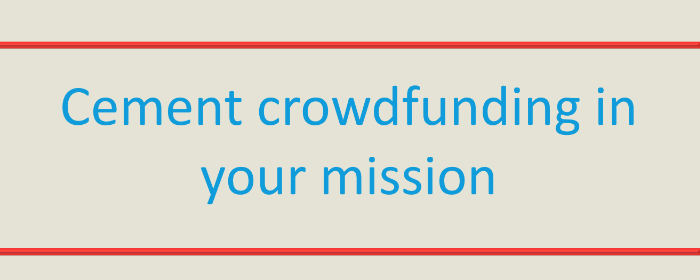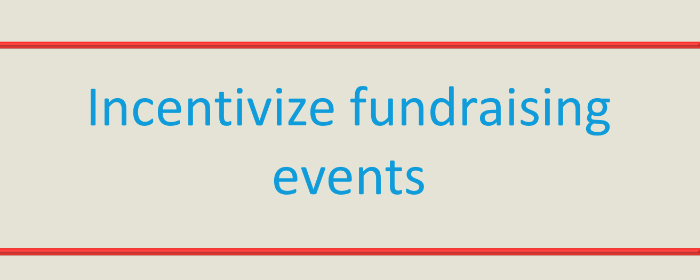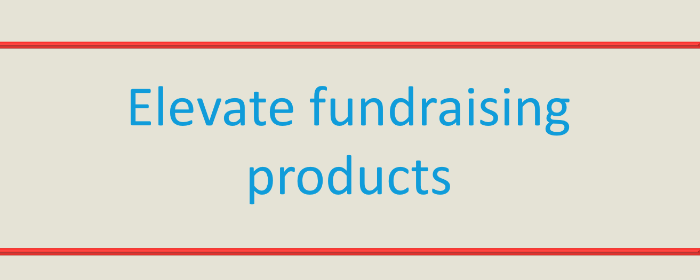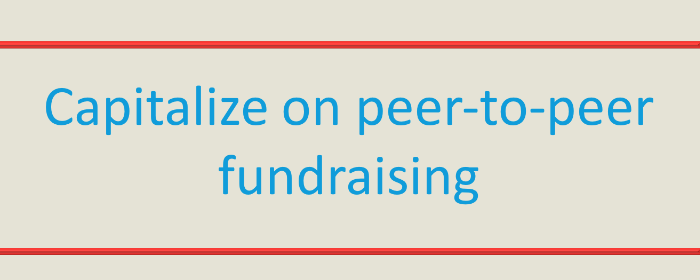Modern nonprofit fundraising is more than writing an appeal letter and waiting for donations to pour in. Of course, fundraising letters are still important and valuable tools, but donors and supporters often need more incentive to support your organization.
After all, their time and finances are valuable; you need to show them how your organization values its supporters and uses donations to further your cause. That’s why you’ll need to learn about incentive based fundraising.
What is incentive based fundraising?
Incentives are motivators that influence your donors to give and influence your fundraising teams to raise more.
Incentives aren’t just prizes or rewards; they’re a means of demonstrating how much your organization values your supporters.
We’ll be covering the basics of incentive-based fundraising in this article.
Specifically, we’ll cover how to:
- Capitalize on peer-to-peer fundraising.
- Cement crowdfunding in your mission.
- Incentivize fundraising events.
- Elevate fundraising products.
Now let’s get started with the basics.
1. Capitalize on peer-to-peer fundraising.
The Basics:
Peer-to-peer fundraising is a type of fundraising in which your supporters reach out to their own networks to solicit donations.
Peer-to-peer fundraising, or P2P fundraising, is often paired with events like walkathons, but it can stand on its own, too.
Either way, P2P fundraising is best practiced online, where donors can create individual fundraising pages that they can share with friends and family.
Of course, supporters can also make in-person, email, or phone appeals. Ultimately, they have the power to reach out to their networks in the most natural and effective way that they can.
Now, let’s take a look at how you can capitalize on P2P fundraising to build incentive. We’ve broken it down into two sections:
- The Social Influence Factor
- Gamification
The Social Influence Factor
In a way, P2P fundraising is it’s own kind of incentive. After all, the social influence factor demonstrates that we are often motivated by what people around us are doing.
P2P fundraising relies on supporters making asks based on established relationships and trust. As such, these individuals can hold more influence over their networks than your nonprofit.
Wanting to support a family member or friend’s philanthropic work is an incentive for donors to give to a P2P fundraising campaign.
Incorporating social media sharing options into your P2P strategy can help your organization capitalize on the social influence factor; as people share their donations and support, others will be inspired to donate themselves.
Gamification
Gamifying fundraising turns your campaign into a fun experience for your fundraising teams and individual supporters.
You can also capitalize on P2P fundraising by using gamification to create competition and incentivize your supporters.
How do your gamify fundraising and create competition? You can use:
- Product fundraising. Pairing P2P fundraising with products allows your supporters to not only solicit donations but to offer a product in return. You can create competition by using a custom product fundraising platform. Fundraising teams can design their own products, such as t-shirts, and sell them to their networks. Your teams will be inspired to create the best possible design that everyone will love to wear!
- Leaderboards. Leaderboards show your top fundraising teams or individual fundraisers based on how much money they’ve raised. Peer-to-peer software may offer leaderboard integrations that update automatically. These fun features spur friendly competition between supporters as they vie for the top spot, creating a sense of fundraising urgency.
- Fundraising badges. Like leaderboards, peer-to-peer software may offer badges. Badges are usually online icons that supporters earn when they reach certain fundraising milestones. Supporters can display their badges on their personal fundraising pages or share them on social media. Badges are fun to collect and can motivate supporters to reach your highest goals.
Turning P2P fundraising into a competition or game is one of the best ways to motivate your supporters to put their all into fundraising.
2. Cement crowdfunding in your mission.

The Basics:
Though P2P fundraising and crowdfunding are often used interchangeably, they can be different based on the platform that you’re using and the scope of the fundraising.
Crowdfunding usually refers to individuals soliciting donations for a personal campaign, but the same strategy can be applied to nonprofits.
Crowdfunding is a fundraising strategy in which a nonprofit sets a fundraising goal for a specific project and launches a campaign to both current donors and new online supporters.
Crowdfunding campaigns generally offer reward tiers for donations.
For example, a $200 donation may earn a donor an exclusive nonprofit product, such as a custom hat or t-shirt. The incentives generally improve as the donations increase.
In this section, we’ll cover how to:
- Incentivize with recognition
- Offer mission-based rewards
Incentivize with recognition
One low-cost way to incentivize donors and retain them after they’ve given is to recognize them appropriately.
Of course, it’s vital that thanking donors is incorporated as a staple of your fundraising efforts. However, you can still use this fundraising necessity as an incentive by going the extra mile to show your donors how much you appreciate them.
Send a thank you email to all donors, no matter what they give. Your thank you email should include:
- A personal salutation, using the donor’s preferred name.
- Links to engaging material about your nonprofit. For example, you can link to a page about upcoming events or volunteer opportunities.
- And of course, a sincere thank you for the donor’s contribution.
Recognizing donors who give to your campaign can incentivize further involvement with your nonprofit.
Because crowdfunding campaigns have a lot of potential to recruit new donors, thanking them is a vital part of drawing them into your organization.
Offer mission-based rewards
Since crowdfunding campaigns usually involve incentive tiers, you can further incentivize long-term engagement by using your rewards to focus on your mission.
Mission-based rewards can work across low-level and high-level tiers. But what does it mean to offer this unique type of incentive?
A mission-based reward is just that; a reward that stems directly from your nonprofit’s work and the people who are being helped.
A mission-based reward can be a product created by the recipients of your nonprofit’s aid, a unique volunteer or event opportunity, or special insight into your nonprofit’s work.
Let’s take a look at an example to see how this may work in practice.
Imagine that your nonprofit empowers women all over the world. You’re launching a crowdfunding campaign to help a specific group of women in Ecuador.
On your crowdfunding website, you should specify that:
A $100 gift will receive a profile and picture of one of the women in the program.
A $500 gift will receive a handmade craft and a personal thank-you letter from one of the women in the program.
A $1000 gift will receive an opportunity to attend an exclusive event where your nonprofit premieres a video of these women receiving the help they need.
Ultimately, offering mission-based incentives will allow donors to see the impact of their gifts and connect them to your cause.
3. Incentivize fundraising events.

The Basics:
Fundraising events can be an incentive in their own right. After all, if your nonprofit is known for creating a fun, exclusive, and/or meaningful environment for your fundraising events, then people will love to attend.
Event attendance has the obvious benefit of bringing more supporters and donors to your nonprofit. They’re great opportunities to raise funds for your cause.
But first, you need to incentivize people to attend.
For comprehensive information on fundraising events, you can check out this resource, but for now, let’s take a look at these top strategies:
- Turn attendance into a reward
- Boost your auction items
Turn attendance into a reward
While hosting open events that anyone can attend certainly has its merits, you can also turn your fundraising event into an incentive all on its own.
To do so, you can:
- Open the event to anyone who meets a certain fundraising goal.
- Send invitations to specific donor groups, such as major donors or mid-level donors.
- Create exclusive events for your membership program.
In each of these instances, the event itself is the reward that donors receive for contributing to your nonprofit.
To ensure that the reward is meaningful to your donors, you’ll need to create an event atmosphere that your donors will enjoy.
More importantly, you’ll need to advertise the event so that supporters get hyped about wanting to attend.
To do so, you can emphasize:
- Your featured attractions. Your events should have a draw that will make people want to attend. Your attractions could be a nice meal, entertainment, or a unique venue. Your featured attraction should be at the forefront of your advertisements.
- The event atmosphere. A backyard cookout will have a much more intimate, relaxed feel than a gala at an art museum. If your donors know what kind of event to expect, they’ll be more likely to work toward receiving an invitation.
- The community. Everyone who attends your incentive events will have something in common; they have demonstrated their active support for your nonprofit. Donors coming together with other donors is a chance to create community within your nonprofit. Your supporters would likely be interested in a chance to connect with other philanthropically-minded people.
Following these tips can help you create advertisements that act as an incentive to attend your fundraising event. Of course, you can always think outside the box when it comes to relating to your donors; you’ll know what kind of events will motivate them best.
Boost your auction items
Auctions offer a hefty incentive for attendees because of the opportunity to obtain a highly sought-after item. Your auction items, after all, are the stars of your show.
To incentivize more attendance and more donations, you’ll need to choose the best items possible.
Popular choices include travel packages or unique art pieces. However, these types of items can run up your event costs.
To create strong incentive while staying in budget, consider these strategies:
- Solicit in-kind donations from personal connections and sponsors in your community.
- Bundle smaller auction items together to create more desirable and higher-value packages.
- Use consignment companies to gain big ticket auction items. Consignment companies generally only charge your nonprofit for items that are sold at the auction, so you won’t end up “in the red.”
The math is simple; the more desirable your items are, the more bids you’ll receive. For more information on running an auction, you can check out this guide.
4. Elevate fundraising products.

The Basics
Product fundraising can motivate donors to give when they receive an amazing product in return.
That’s likely why product fundraisers are incorporated into most nonprofit fundraising strategies, but you can ensure that your products are as compelling as possible for your supporters by understanding what they want.
In general, your supporters want more than a cool product; they want to show their support for your organization.
You can meet your supporters’ expectations by:
- Branding products
- Going digital
Branding products
Donating to your organization is one way for contributors to show support. Another way to show their support is to wear or use your product in their daily lives, as long as the product is branded.
A branded product should display:
- Your nonprofit’s name,
- Your nonprofit’s logo,
- And/or your nonprofit’s colors.
The goal is that your nonprofit should be recognizable and visible through your product.
For example, let’s say you create a custom t-shirt to incentivize donors to give to your organization. If your t-shirt is branded properly, your supporters advertise your nonprofit every time they wear the shirt.
And of course they’ll wear them.
Many people want to demonstrate their support for nonprofits. It not only reassures them that they’re making an impact with their donations, but it can also draw new supporters to an organization that they care about.
Creating branded t-shirts (or any products!) allows your supporters to showcase their involvement in your nonprofit.
For more information on how nonprofit’s brand themselves, check out this Fundly resource, which lists nonprofit names, logos, and mission statements.
Going digital
When it comes to product fundraising, you may think of Girl Scouts knocking on your door to sell cookies or booths of branded gear at fundraising events.
With nonprofits rapidly adapting to technological advances, product fundraising is gaining a larger, digital presence.
Offering a product fundraiser over the web is a great way to spread your campaign to new donors and supporters.
The ability to purchase products online is a convenient, accessible way for donors to support your nonprofit in the context of their daily lives.
To bring your campaign online and incentivize donors further, you can:
- Incorporate social media sharing. Allowing donors to share their product purchases on social media is a way for your supporters to draw their networks to your organization. Plus, they’ll receive recognition for their support from their friends and family! This feel-good incentive works organically from the people your supporters know personally.
- Create high-quality online content. The internet poses the opportunity for your organization to spread content that stirs your donors’ emotions. High-quality videos, for example, can show supporters why the recipients of your aid need what they need and how purchasing a product can help. Products are visual; use this to your advantage.
- Celebrate supporters on social media. Products are great for social media because supporters can take pictures of themselves using or wearing the product. Encourage your supporters to do so by creating a hashtag or hosting a t-shirt day, for example, where you like, share, or retweet pictures of your supporters wearing their custom branded nonprofit t-shirts.
Since product fundraising can incentivize donations and reach new supporters, you’ll want to provide a digital framework that allows your supporters to share their love of your products and your organization.
Incentive-based fundraising is all about understanding what kinds of opportunities will motivate your supporters to donate and spread the word about your campaign. The best kind of incentive promotes long-term engagement and can work across any fundraising campaign.
Now that we’ve covered the basics, you’re ready for the advanced course: Raise More Money: Incentive-Based Fundraising 202
You know your donors best! How can you use these strategies to boost your incentive based fundraising? Let us know in the comments!
________________
Kerri Moore is the Director of Marketing at Booster, Created by CustomInk. She and her team help create content aimed at maximizing organizers’ fundraising potential and furthering their mission to raise awareness for the cause or passion that means the most to them.







